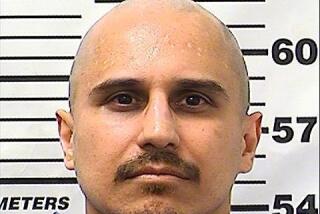Nightmares Continue for Some Jurors
For those who condemned Richard Ramirez to die, the most difficult moment in their long ordeal came on a muggy morning in mid-August, when the judge ordered them to resume deliberations.
It was only two days after fellow juror Phyllis Singletary had been murdered by her boyfriend and only a day after a distraught alternate was picked as her replacement.
Inside the jury room, there was total silence.
“It was traumatic. We were all in shock,” recalled juror Donald G. McGee. “I just wanted to get away. I sat there and looked at Phyllis’ seat and saw her face. It really hurt us. We had been together for a long time.”
Finally, foreman Felipe Rodriguez spoke.
“Keep in mind that this has nothing to do with what we’re doing here,” he told his grieving colleagues. “That’s something separate.”
Then Rodriguez, an employee of the city of Los Angeles’ Bureau of Street Lighting, encouraged all panel members to discuss their feelings. Gradually, one juror after another spoke up.
“We just talked about her for a while,” said Cynthia E. Haden, an administrative assistant in a bank.
They decided to send a bouquet of flowers to Singletary’s family.
Only then, McGee said, “were we able to get over our grief. But we just had to go on. We had a job to do. That part really hurt us, but it didn’t distract us.”
Still, that watershed moment in the 8-month Night Stalker trial is sure to be spotlighted in the years ahead as defense lawyers pursue their appeals of the 19 death verdicts handed down Wednesday by the jury of seven women and five men.
Even as the jurors had resumed their deliberations on that Aug. 16, defense attorneys Daniel V. Hernandez and Ray G. Clark were insisting to reporters that the clearly traumatized jury could no longer fairly and dispassionately deliberate their client’s fate.
But all 12 jurors said in interviews Wednesday that they did not let Singletary’s murder affect their decision-making.
“We didn’t think her death had anything to do with the way our verdicts went,” said Mary Helen Herrera, a mail carrier, who replaced Singletary.
Hours after returning their 19 death penalty verdicts in Los Angeles Superior Court, 11 of the jurors, along with several alternates, met at the home of juror Shirley Zelaya, also a postal worker, in South-Central Los Angeles.
Over beer, wine and spaghetti, they spoke, often raucously, of their trials and tribulations with a mixture of pride, hilarity, curiosity and, most of all, sadness over Singletary’s murder. Her boyfriend committed suicide a day later as police closed in on him.
“We had really become a family,” said Arlena Wallace, an insurance sales representative.
The jurors also mourned for the victims and relatives of Ramirez’s rampage.
“Our heart goes out to those people,” said McGee, an assignment clerk at GTE.
McGee said he, like most jurors, was deeply disturbed by the gruesome color photographs of the victims and the crime scenes.
“I’ve spent some time in the service, so I’ve seen dead bodies. And I’ve worked in a hospital emergency room and seen bodies mutilated. But nothing--ever--like what I saw here,” he said.
Despite what some of the jurors called the “total, sheer brutality” of Ramirez’s crimes, many said they had great difficulty in reaching the death penalty verdicts.
“It was the hardest thing I’ve ever done in my life,” said Martha Salcido, another postal worker. “Have you ever had to decide that someone should die?”
She made up her mind only after thinking about Ramirez’s victims and their relatives. “That made it easier,” Salcido said.
Another early fence-straddler was Haden.
“It was hard for me to give the death penalty,” she said. “I feel bad for Rick (Ramirez), for his parents, for the victims. I feel bad for everybody involved. I’m sad.”
In the end, Haden said, “I looked at it as the honorable thing to do. He’ll finally be doing something right--atoning for all the deaths that he’s caused.”
One after another, the jurors also re-lived their personal horrors inspired by the case. Almost everyone said they have had countless nightmares about the Night Stalker crimes.
“I’ve had them from the start--like he was there in the room with me,” said Lillian Aragon, a secretary.
“I still have them,” Haden added.
“My nightmares--I can’t even talk about them,” said Arthur V. Johnson, a letter carrier.
Herrera said she still awakens in the middle of the night and gently touches her husband’s head, as if to assure herself that he had not been shot, as had six of Ramirez’s victims.
Many others said they have become extremely light sleepers as a result of the Night Stalker crimes, in which Ramirez often gained entry into a residence through an unsecured door or window.
“I hear everything now,” Haden said.
Most also said they now take extra precautions.
“I have all my windows closed and at least three of the lights on all the time,” Herrera said.
Jurors also recalled the times during the trial when Ramirez would fix his gaze at individual jurors.
“We all felt he was trying to intimidate us,” Aragon said.
Several jurors also told of fears for their personal safety when they learned of Singletary’s murder on the night of Aug. 14--mostly from television news bulletins. At the time, it had not been determined who had killed the woman.
Haden was in her Glendale home--only two blocks from the scene of a Night Stalker double homicide--when a news flash interrupted a late-night TV movie.
“My first thought was that we were all going to be picked off, one by one. Who’s next?” she recalled.
Her roommate got his gun out and kept it handy.
Moments later, Haden got a frantic call from Chakalit Harris, another juror, expressing the same concern.
But Harris was less fearful for her own safety. During the course of the trial, she had installed window bars on her home--and had bought a third dog, a Great Dane.
When Rodriguez heard the news, while watching an Angels baseball game, he quickly gathered up his two children and locked up the house. His wife was still at work.
Many jurors also said they were surprised that Ramirez’s lawyers did not call any witnesses during the penalty phase of the trial who might have testified sympathetically about Ramirez.
“We were absolutely surprised,” McGee said. “We had expected to have something to sift through. But there was nothing.”
McGee was the lone juror who did not attend Zelaya’s party. He went back to work.
The jurors also recounted how they methodically reviewed all the evidence and then debated at great length before reaching guilty verdicts on all 43 felony counts against Ramirez, including the 13 murders.
“The evidence was so involved,” McGee said. “That made it really a struggle.”
Many jurors said they bought the prosecution theory that, in killing the men in the house before robbing and assaulting the women, Ramirez had committed the “ultimate acts of cowardice.”
In their deliberations, jurors said, they gave Ramirez every benefit of the doubt.
The hardest case to decide, they said, was the murder of 79-year-old Jennie Vincow in Glassell Park, who was stabbed to death in late June of 1984--almost nine months before the rampage of other Night Stalker murders had begun.
Even though Ramirez’s fingerprints were on a window screen that was found on the floor of Vincow’s living room, McGee said, some jurors wondered about the possibility that Ramirez had left that print there earlier.
“A lot of people were saying, maybe, maybe, maybe,” he recalled. “There were a lot of questions like: Are you sure? There were a lot of arguments back and forth. But it was never personal.”
When it became clear that there was no unanimity on this first so-called Night Stalker “incident,” jurors abandoned any notion of taking votes by incident in chronological order. Instead, they meticulously reviewed all the hundreds of pieces of evidence in each of the 15 incidents.
“We went through the entire package,” McGee said.
Only then, he added, did it become clear that Ramirez had slain Vincow.
“She had been stabbed with almost the exact type of wounds” as in many of the other cases, McGee said.
At the post-verdict party Wednesday, the jurors and alternates appeared at once drained and festive. Many spoke of reunions. Halloween would be an appropriate first reunion, several suggested, laughingly.
More to Read
Sign up for Essential California
The most important California stories and recommendations in your inbox every morning.
You may occasionally receive promotional content from the Los Angeles Times.










